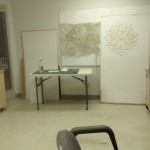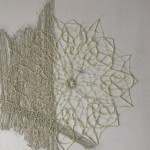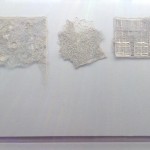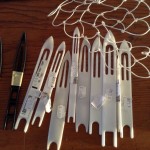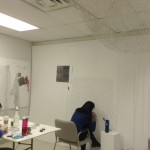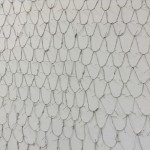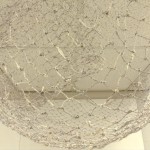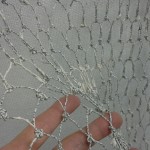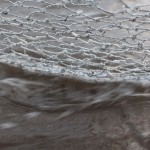Paper as material and metaphor has been a focus in my work for many years. I am specifically interested in exploring the connections between paper and words, text and textiles. I am currently working on a series of paper weavings/drawings/sculptures using the pages from three books: À la Recherche du temps perdu by Marcel Proust, Ulysses by James Joyce and The Waves by Virginia Woolf. I now see that this is an undertaking of several years and not just one year as I had originally planned.
I imagine this work as a way of physically deconstructing and re-presenting the narrative structures as well as the actual physical gestures and writing processes used by each of these authors – a re-reading and re-writing of each of the books. In using spinning and weaving, I am remembering through my fingers, the oldest technology and art developed by humans. It is an art form and contribution to culture made largely by women for over 24,000 years, a contribution that remains undervalued. Vestiges of this history are found in our language and in expressions, such as hanging by a thread, spinning tales and the tightly woven fabric of our society.
I chose these specific works because of their strong connections to the textile arts. À la Recherche du temps perdu and Ulysses were used in previous installation and performance projects, Le lit de Proust : en attente d’un baiser, 2006 and Cette nuit, Défaire, 2008. I am including Virginia Woolf’s The Waves because I love her writing and this work especially so. I propose to “weave” these three novels without the use of a loom; winding thread over thread, so each “book” will take on a distinctly individual character and volume.
I begin the work without sketches or models. I am using the Japanese technique, ‘shifu’ to spin the pages of books into paper threads. Each page is cut into one long narrow strip, humidified over night and then spun into a malleable thread. Allowed to dry, the threads take on whatever shape I choose to impose. Until now, I have used primarily threads from dictionaries to make sculptures, weavings and installations. Finding editions printed on quality paper is very important.
The Proust Project
Sometime in February 2016, I began working on what I have been calling, The Proust Project: a triptych of hybrid drawing/sculpture/weaving made with paper thread spun from the pages of a Pléiade, three-volume edition of Marcel Proust’s À la recherche du temps perdu. In January 2017, I brought it with me to continue during my residency at the Université de Moncton.
When I began the project, I had no clear idea of what this work would look like. Neither sketch, nor model was made in preparation for what has turned out to be an epic adventure. Perhaps epic is a slight exaggeration of terms when compared to the actual writing of the book. It took Proust the better part of his adult life to complete and he died before it was published or even edited and he was famous for his add-on edits.
With only two colours at my disposition: the white-cream margins of the paper and the greyish text-body, I separated the text from the margin and cut each onto long single strips. Using the Japanese technique shifu, which I refined during my residency in Tokyo in 2014, I spun the strips of paper into threads.
I decided to let my response to reading Proust and his process influence my own process. For the first volume of the triptych, I started by making a series of small, square and circular weavings, imagining the many characters of the novel as a series of constellations or stars. Slowly, I linked these “characters” together to create one large work. In the second volume, using the white, margin threads only, I began by making the outline of a geometric shape, inspired by the window of the church in Illray, – the village of Proust’s childhood. I then proceeded to make a series of scribble –like lines to crisscross the window structure, effectively blurring the original structure. For the third volume, I was inspired by his writing process, visible in the manuscripts, with his’paperoles’ as he termed them – the multiple add-ons tacked onto the margins and between the lines . Keeping the page margins intact and unspun, I used them to create a building-like structure, weaving the spun text threads in and out of the structure. Constantly working to create a fragile balance between a sense of chaos and order was my principle guideline.
My fingers wrists and arms are beginning to feel the wear of the work. I am very grateful for the wonderful help of my two interns from l’Université de Moncton: Suzanne Cormier and Fanny Rasoamiaramanana. The actual completion of the third and final volume in the triptych continues to elude me. For the moment, I have set it aside and started working on The Waves Project. Sometimes, work just needs to rest. I will begin it again later with fresh eyes.
The Waves Project
I have been swimming regularly for years, slowly increasing the distance and the number of times per week. This year, I learned how to do the tumble turn – a beautiful curving flourish for the boustrophedon-like writing that my body does in the water. An accomplishment that has increased the speed, the muscle and pleasure of the back and forth banality of exercising in a pool. As much as I love swimming and the water, I remain a cautious swimmer with a heightened respect and fear of the power of water. I suffered from two recurring nightmares: one as a child, the other as a young woman. After my mother died, I repeatedly dreamt my family was on a huge ocean liner. In Titanic-style, the boat was sinking. There was much panic and little help. I would wake up terrified and climb into my father’s bed. Only six at the time, I was quite small and my father quite big. He held on to me tightly, too tightly and I would wake up suddenly feeling like I was suffocating. This went on and on, for I don’t really know how long. Finally, I remember telling myself that the only answer to my dilemma was to learn how to swim.
To this day, the fear of drowning remains quite present. I can only imagine that Virginia Woolf must have been quite outside herself, or extremely committed to drowning in order to be able to fill her pockets with stones and walk into the River Ouse. The body wants to live and will do anything to fight to survive. The mind must be very strong to be able to over-ride the instinct for living.
It seemed important for me to know what it was about water and the waves that inspired Virginia Woolf to write The Waves, her most experimental novel, a ‘play poem’ as she called it. I have been reading, looking for the answer which I finally found in ‘A Sketch of the Past ‘ in Moments of Being. In her words….If life has a base that it stands upon, if it is a bowl that one fills and fills and fills – then my bowl without a doubt stands upon this memory. (one of her first) It is of lying half asleep, half awake, in bed in the nursery at St-Ives. It is of hearing the waves breaking, one, two, one, two, and sending a splash of water over the beach; and then breaking, one, two, one, two, behind a yellow blind. It is of hearing the blind draw its little acorn across the floor as the wind blew the blind out. It is of lying and hearing this splash and seeing this light, and feeling, it is almost impossible that I should be here; of feeling the purest ecstasy I can conceive. Pages 64-65, Moments of Being. The rhythm of sounds and light, burnt into her memory.
I am currently finishing the first term of the first year of a two-year residency at L’Université de Moncton in Moncton and preparing to begin the second term at Mount Allison University in Sackville, New Brunswick. Over twenty years ago, upon finishing a sabbatical replacement teaching position at Mount Allison, someone gave me an antique wooden fishnet needle. When I returned to this area, I brought the needle with me; I knew I had to pick up the dropped thread and learn how to use it.
The director of communications of l’ Association acadienne des artistes professionnel.le.s du Nouveau Brunswick and friend, Jean-Pierre Caissie took me and Suzanne to meet his uncle, Robert Maillet, a lobster fisherman in the area. Robert’s father and mother, Raymond and Alcida received us and gave us a demonstration on how to make a net for a lobster trap. We agreed to return later with others for a hands-on course in how to use the needle and make a fish net.
As a result, Suzanne, Fanny and I have been busy experimenting and making a variety of nets using the Webster’s New Collegiate Dictionary. For the Waves Project and my residency on the Atlantic coast, the fishnet feels like an ideal metaphor for writing or for any creative act – a reaching out into the unknown.
- Getting Started
- Beginning Volume 2
- The Proust Project almost completed
- Monsieur Maillet
- Fishnetting needles and net
- Fanny & Suzanne at work
- Japanese Wave Pattern
- Fishnetting with English Dictionary
- Detail of paper net
- Paper thread rope
- Japanese wave pattern
- Video trial with paper net
- Detail of net in water
- Suzanne, Fanny and me, photo by Paul Litherland
